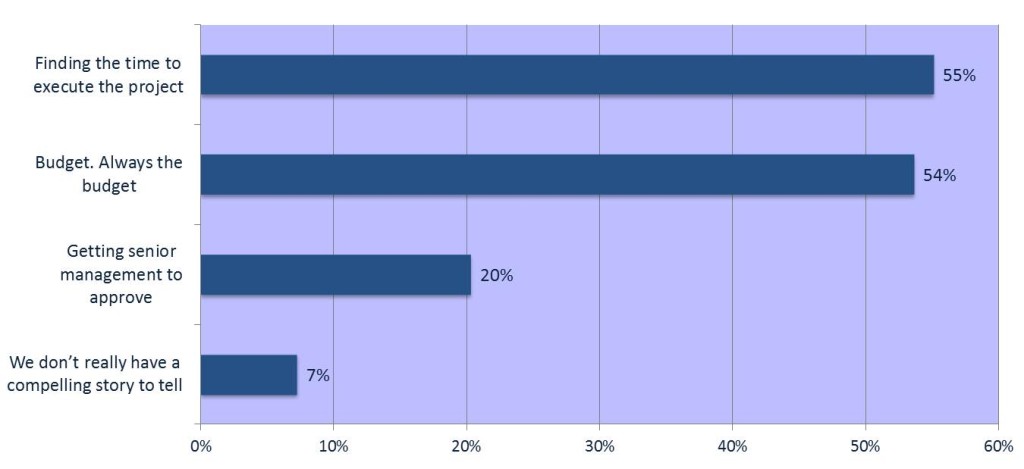 Our recent survey of senior marketing executives asked what their greatest challenge was in developing compelling content. Predictably, two reasons stood out: time and budget constraints – see chart below:
Our recent survey of senior marketing executives asked what their greatest challenge was in developing compelling content. Predictably, two reasons stood out: time and budget constraints – see chart below:
What constrains you from being able to create compelling online/marketing content?
Here are six ideas on how to overcome this challenge and effectively create online content:
- Define the project – This sounds obvious but many marketers start with existing content and try to fit it into their campaigns. Before you begin, it really helps to have clarity regarding the goals driving your content creation. What outcomes are you looking to achieve and by whom? Assuming that you are trying to engage a target audience, do you know what their current challenges are with respect to the products and services you offer? At what point in their purchase process are you trying to engage them? What information do they already have and what do they need to move to the next stage of their purchase process? Answering these questions will help you to clearly define your content strategy and the compelling story you need to tell.
- Gather sales insights – Sometimes it’s not fully understanding the buyer’s journey that’s the issue. Talk with sales and others who have customer-facing roles to understand the questions that prospective customers ask during their interactions – whether they give good answers or not. Of course, it helps to gather the best answers so that you can share them throughout your organization as well as packaging them as content for the intended audience.
- Ask the customer – Done right, market research and targeted surveys in particular can lead to valuable insights that are the starting point for great content. For example, when a SimplyDIRECT client, Kronos, surveyed dining industry management about their time-management practices, they found that many used their point-of-sale systems to keep track of employee hours. Kronos knew that pending industry regulations were going to render these current practices insufficient for upcoming reporting requirements. Survey results revealed an opportunity for Kronos to develop content and messaging which explained these pending regulations to help dining management pro-actively address these largely unrecognized industry changes.
- Give the gift of time – While whitepapers provide you scope to fully describe your ideas they can be lengthy, weighty, and time-consuming-to-read (and write!). With limited time available, buyers are increasingly looking for quicker ways to meet their information needs. Infographics, video clips and short articles are becoming more popular. Also thought leadership shouldn’t equate to pure opinion. Unless you are a well-known expert, assembling a succinct and scannable series of facts that illustrate you point will likely have a much greater impact than a lengthy opinion piece. In fact, simple checklists can be of significant value and a great way to enticing the reader to absorb the points you want to make.
- Improve budget leverage– One way to stretch your budget is to develop joint programs with other departments. For example, conducting a prospect survey yields both actionable content and quality marketing leads. Additionally it provides vital customer intelligence that can be used by sales to penetrate target accounts. Approached as a joint project with common goals, shared projects improve organizational alignment while allowing sales management (or another function) to share the cost. Of course, each department’s management needs to be convinced of the value of the project and its ability to meet their own goals – e.g. for sales, to drive an increase in pipeline and sales conversions.
- Reuse and repurpose – Some content is always relevant while other content ages quickly. But just because it isn’t new, doesn’t mean it isn’t valuable. Older blog posts featured some time ago can be updated and rerun, with a different title perhaps. Case studies can be dusted off and prominently featured with an updated introduction or new quotes. Often existing materials can be repurposed by adding the latest market research results, industry developments, competitive information etc. You can stretch the value of your content by repurposing it across different mediums. Take a whitepaper and turn it into a Slideshare presentation. Take an article and have a customer and an industry expert discuss its content in a webinar or podcast.
The key to great content is that it must be timely, relevant, and remarkable. While great content is vital, you can be creative in generating a content development strategy that makes efficient and effective use of available resources. Existing content, other departments, and sales-team members are all great options for alternative sources of content development. Check them frequently for new ideas and inquire companywide for volunteer writers and guest bloggers – you might be pleasantly surprised at the creativity you find!
Ultimately it’s your customer or prospect who determines the value of your content. Click the image below to download the SimplyDIRECT Buyer’s Guide to Survey-based Lead Generation to find out more about leveraging surveys for content creation and lead generation.
What additional ideas do you have for creating compelling content?


